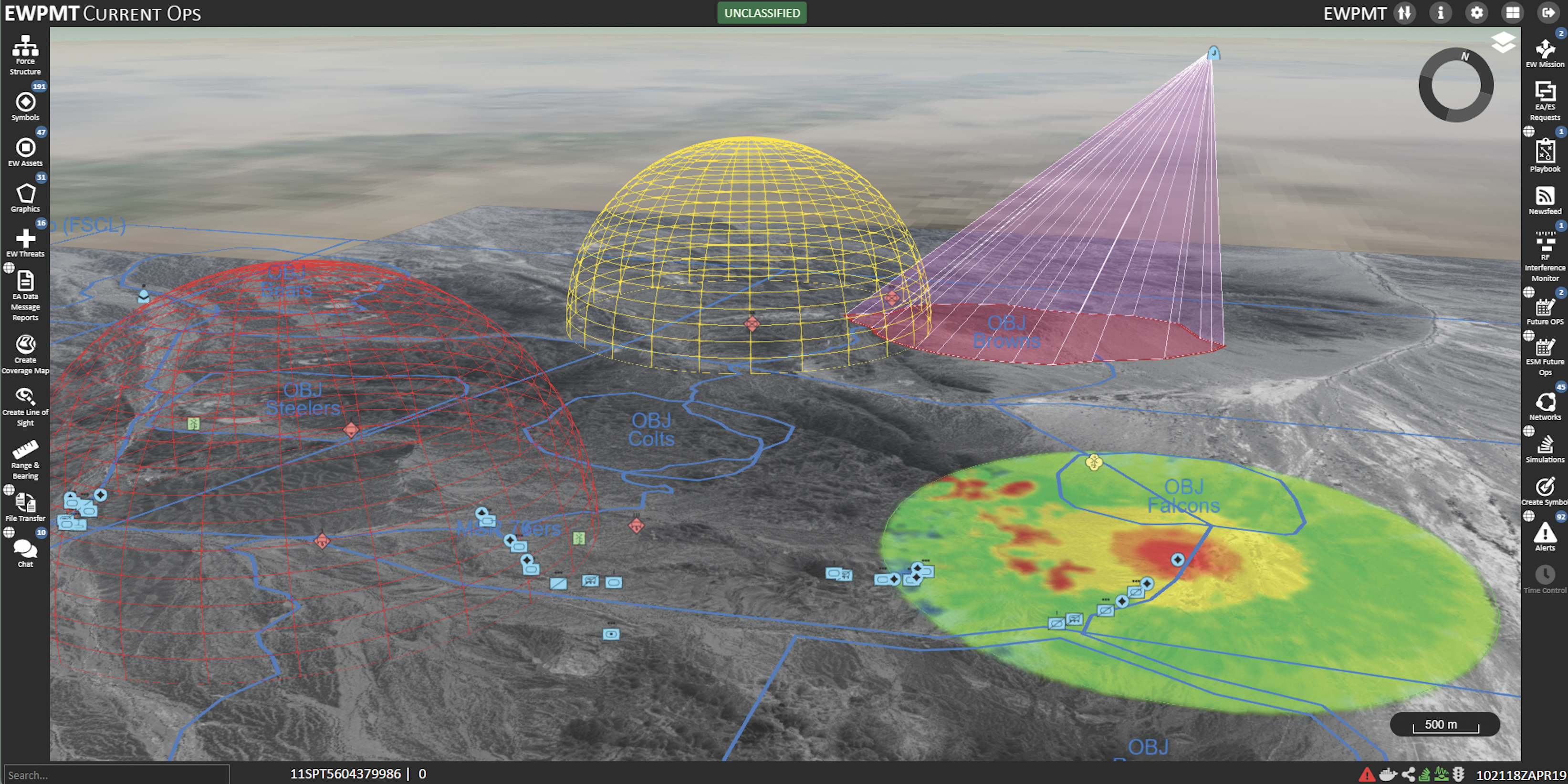
Graphic showing the interface of the Army’s Electronic Warfare Planning Management Tool (EWPMT), showing both threat and friendly EMS data. (Picture courtesy of the Army.)
WASHINGTON — The Army is making progress on two of its most critical electronic warfare (EW) programs as the service seeks to “reestablish its dominance to the spectrum for the next fight,” according to a service official.
“I think we’re on the cusp of greatness here in the EW portfolio after a few solid years of investment, lots of support from the Army and from [the Defense Department] to regrow the Army’s capability, and equipment’s coming,” Kenneth Stayer, project manager for EW and cyber, said in a May 1 interview.
That equipment will come in the form of the service’s Electronic Warfare Planning and Management Tool (EWPMT), built by Raytheon, which is meant to allow a commander to better visualize and plan operations in the electromagnetic spectrum on the battlefield. The Army has already fielded parts of the system to select units, but next fiscal year it will go into a full scale fielding.
He did not disclose which units will be fielded with EWPMT, but added that the service will continue to develop the system because there is “a large backlog of requirements that we want to get at.” Strayer told Breaking Defense last year that the system will add new capabilities that will allow it to connect to sensors, complete new modeling and analysis, and understand parts of the EW environment.
“So we’re right now in a competitive phase,” Strayer said May 1. “There is a [request for proposals] out on the street that vendors are proposing to right now. And we should get those proposals in next month and then plan to award a contract early next year.”
In its fiscal 2024 budget request, the Army requested $6 million to mature hardware and software capabilities that will “enable an Assured Position Navigation and Timing (APNT) system to function as a Navigation Warfare (NAVWAR) sensor” that will allow EWPMT to create a NAVWAR common operating picture. The service also requested $2.2 million to integrate NAVWAR “Situational Awareness,” a new start effort, into the program’s software, including developing application program interfaces and testing.
Strayer added that the Army Cyber Center of Excellence is currently incorporating feedback from soldiers using EWPMT into the next requirements documents for the program, which should go through the Pentagon next year. The service also plans to start incorporating algorithms into the “tool set” of EWPMT next year.
“We have rudimentary capabilities now in terms of being able to fuse sensors and to look through data to identify specific things we’re looking for,” he said. “The future of AI and machine learning, it’s definitely a growth field and there’s lots of activity we would like to get that this domain obviously is right for…given the massive amount of data that we collect and the way that the threat rapidly changes, and we want to be able to identify things intelligently.”
While the Army progresses on EWPMT, the service is getting ready to demonstrate, and potentially field next year, another effort meant to provide an active jamming capability to its brigade combat teams (BCT).
Strayer said the service has its first three prototypes of the Terrestrial Layer System-BCT built onto its Stryker platforms.
“Those three platforms will be going to an operational demonstration this fall,” he said. “And assuming the success coming out of that demonstration, then we will be positioned to issue those systems out to the first unit fairly quickly after the demonstration, so probably mid-2024.”
The Army also just started prototyping another configuration of the program on the heavy Armored Multipurpose Vehicle, “which is designed for the heavy brigades,” he added. That prototyping is going on this year, with a projected FY25 delivery.
“And then the third configuration is for the Infantry Brigade Combat Teams, and it’s a soldier worn man packable version, so little [less] capability, but designed to be lightweight and carried by soldiers out on the ground. And we have an ongoing competition right now to select a commercially available product that we can rapidly buy into next year,” Strayer said.
Last year, Lockheed Martin and General Dynamics Mission Systems won contracts for another configuration of the system, called the TLS-Echelons Above Brigade, which is meant to provide formations larger than the brigade level with longer-range EW systems.
Strayer said both vendors are completing an initial design phase for TLS-EAB and either one or both companies will be selected to build out prototypes, which will be demonstrated in FY25. Fielding of TLS-EAB is projected to begin in the FY26-27 timeframe, he added.






















